![]()

![]()

![]()
pontil - A hollow iron rod used to gather molten glass for blowing; also called a punty.
popular culture - Low (as opposed to high) culture, parts of which are known as kitsch and camp. With the increasing economic power of the middle- and lower-income populace since the beginning of the Industrial Revolution in the nineteenth century, artists created various new diversions to answer the needs of these groups. These have included pulp novels and comic books, film, television, advertising, "collectibles," and tract housing. These have taken the place among the bourgeois once taken among the aristocracy by literature, opera, theater, academic painting, sculpture, and architecture. But modernist artists rarely cultivated the popular success of these new cultural forms. Modernist works were little appreciated outside of a small elite. Life magazine's 1950s articles on the abstract expressionist Jackson Pollock (American, 1912-1956), and the silkscreened paintings by Andy Warhol (American, 1928?-1987) of soup cans and celebrities signaled unprecedented fusions between high and low art and the transition to the postmodern age.
Quotations:
Also see brummagem, counterculture, ephemera, gewgaw, high art, low art, mass media, memorabilia, paint-by-number, Pop Art.
pornography - Pictures, textures, or other material that is sexually explicit, typically equating sex with power and violence. The human bodies depicted in pornographic imagery are typically flawless and vulnerable, commodified rather than celebrated. Significant issues in the consideration of nudes in any context include: their gender, the gender of those who produced them, the gender of those who paid for their production, and the motivations of each of these people, as well as how these depictions are viewed in cultures other than those for which they were originally produced. Also, the presentation or production of pornographic material.
Also see erotica and erotic art, feminism and feminist art, First Amendment rights, fig leaf, beauty, love, obscene, vandalism, and voyeurism.

porphyry - A hard igneous rock, originally recognized as the Egyptian variety now known as "Imperial" porphyry containing crystals of feldspar in a purplish groundmass. It was prized in the sculpture and architecture of the ancient Romans as well as by later civilizations. Also considered porphyry are rocks of other colors including a green variety from Greece which dotted with green bits of feldspar.
(pr. POR-fə-ree)
Example:
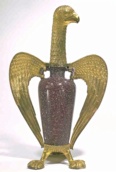
The Eagle of Abbot Suger, a liturgical
ewer in the form of an eagle; the vessel
is of Roman antiquity, the mount from before
1147; the vase: porphyry; the mount:
silver gilt,
incised, engraved, and inlaid
with niello; 17 x 10 1/2
inches (43.1 x 27 cm), Louvre.
Also see stone.
portal - In architecture, a door or gate, usually of importance or large in size. In most Gothic cathedrals there were three portals in the main façade.
Related link:
The Glossary of Medieval Art and Architecture defines "portal" and provides an illustration.
portfolio - A portable case for holding material, such as loose drawings, photographs, or other images. It may also be the materials collected in such a case, especially when they are representative of an artist's work. By extension, a portfolio might be a portable collection of originals or reproductions of an artist's work in a format other than the traditional case — as a set of digital images online or on a disc for example.
Examples:
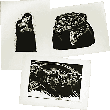
Käthe Kollwitz (German, 1867-1945),
The Widow I, The Mothers, and The Volunteers
from the portfolio Seven Woodcuts about War, 1922-24, woodcuts,
edition: 200, sheet: each
18 5/8 x 26 inches (46.7 x 66 cm). Publisher: Emil Richter, Dresden.
See Expressionism.
![]()
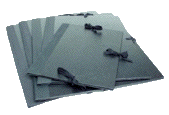
![]()
Contemporary inexpensively manufactured portfolios in five sizes. Each of these fold along one edge, with ribbon ties at the other three.

A contemporary woman walking with an extra-large
portfolio, equiped with straps for carrying from one shoulder
and with one hand.
Also see bin, collection, flat file, graphic design, polypropylene, solander box, stack tray, and storeroom.
portico - In architecture, a porch or walkway with a roof — either open or partly enclosed — supported by columns and often with a pediment, usually leading to the entrance of a building. It has been a standard feature of classical and neoclassical styles. Porticos can be one or more stories high, and may be as narrow as a door or as wide as an entire building. Porticos an galleries are often confused, and some can be described as being both. The plural form can be either porticoes or porticos. Each can have a colonnade, and each can be a long porch.
Example:

Andrea Palladio (Italian, 1508-1580), Villa Rotonda (Villa Capra), begun 1567,
general view of exterior, Vicenza, Italy. This building has an
identical portico on each of four sides.

Portico at the Entrance to Dundurn Castle, c. 1900?, Hamilton, Ontario, Canada. This portico
displays the Doric order,
and can also be called a porte-cochère because a driveway
passes through it.
Also see belvedere, colonnade, loggia, pergola, peristyle, portal, and pronaos.
Portland cement - See cement.
positive - Displaying certainty or affirmation; a synonym for "yes," and as in judgment, positive can signify approval. It can also mean irrefutable. Or, a quantity, number, angle, direction, or space that is opposite to another designated as negative. In photography, an image having values and colors of light and dark areas of the image as in their original and normal relationship, as seen in nature, light areas appearing light and shadows appearing dark, as typically seen in a print — an image produced in a photographic emulsion, typically on a sheet paper by exposure to light that passed through a negative, and to development in photosensitive chemicals. In cinema, a motion-picture print. In printmaking, a printing plate with light and dark areas in their natural relation to those seen by the eye.
When used as a descriptor of attitude, positive suggests helpful or encouraging qualities.
Quote:
Also see art criticism, attitude, beauty, bias, cute, nice, praise, pretty, silhouette, sublime, and value.
positive space - Space in an artwork that is positive — filled with something, such as lines, designs, color, or shapes. The opposite of negative space.
Examples:

Orange shapes occupy positive spaces in this
image, while negative
spaces between the orange shapes form
triangles, or a six-pointed
star.

Violet shapes occupy positive spaces, but
a negative space between them forms a square.

Green shapes occupy largely positive spaces,
but negative spaces within and between them might be seen to
form a cube.
Related link:
Also see closure and negative space.
post and lintel - In architecture, the simplest and oldest way of constructing an opening. Two vertical structural members called posts were used to support a horizontal member called a lintel or beam, creating a covered space.
An example of post and lintel:
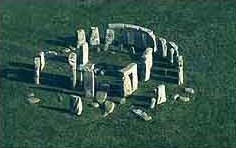
Stonehenge, c. 2,500-1,500 BCE,
stone, height
162 inches, and located 330 feet above sea level on the chalk
downland of Salisbury Plain, about 80 miles west of London near
the town of Amesbury. Large stones
(megaliths) standing upright
(dolmen) with a horizontal
stone balanced upon them (post and lintel). Numerous such structures have survived from
Stone Age France and England. About
half of the original monument is missing, but enough remains
to provide an idea of what it was once like. It was built in
three phases. The first phase saw the digging of the "henge"
that encloses the main area in about 2800 BCE,
and the first arrangement of stones erected c. 2100 BCE.
Once on site, a "sarsen stone" was prepared to accommodate
stone lintels along its top surface. It was then dragged until
the end was over the opening of the hole. Great levers were inserted
under the stone and it was raised until gravity made it slide
into the hole. At this point,
 the stone stood on about a 30° angle
from the ground. Ropes were attached to the top and teams of
men pulled from the other side to raise it into the full upright
position. It was secured by filling the hole at its base with
small, round packing stones. At this point, the lintels were
lowered into place and secured vertically by mortice and tenon
joints and horizontally by tongue and groove joints. It was begun
by people of the late Neolithic period and completed by a Celtic
people called Beaker Folk for their use of pottery drinking vessels,
began to use metal implements and to live in a more communal
fashion than their ancestors. The popular story has been that
Stonehenge was built by the Druids, but they were Celts present
during the much later time of Roman occupation.
the stone stood on about a 30° angle
from the ground. Ropes were attached to the top and teams of
men pulled from the other side to raise it into the full upright
position. It was secured by filling the hole at its base with
small, round packing stones. At this point, the lintels were
lowered into place and secured vertically by mortice and tenon
joints and horizontally by tongue and groove joints. It was begun
by people of the late Neolithic period and completed by a Celtic
people called Beaker Folk for their use of pottery drinking vessels,
began to use metal implements and to live in a more communal
fashion than their ancestors. The popular story has been that
Stonehenge was built by the Druids, but they were Celts present
during the much later time of Roman occupation.
Emilie Benes Brzezinski, Lintel, 1993, cast bronze, 128 x 177 x 28 inches, Grounds For Sculpture, NJ. Lintel was first sculpted from cherry wood, and then cast into bronze at the Johnson Atelier Technical Institute of Sculpture.
Also see column, fenestration, pillar, pier, portal, ridgepole, torii, and trabeation.
posterity - Future generations; or all of a person's decendants. What motivates an artist (or a collector or an educator) and to work really hard and well at it is most likely to be: pleasing oneself and the contemporaries about whom one most cares. Right alongside this in importance: leaving behind a legacy for posterity.
(pr. pə-STA-rə-tee)
Quote:
Also see change, civilization, commemorate, death, desco da parto, documentation, donation, enthusiasm, heritage, installation, love, masterpiece, memorial, memory, posthumous, quality, quality of life, success, time, and vanitas.
posthumous, posthumously - Happening or continuing after one's death. When applied to a work of art, posthumous might indicate works that are printed or cast after an artist's death, as with a posthumous edition. It might refer to works completed by others that were left unfinished at the artist's death, or to changes in thinking (art criticism or art historical re-assessments, praising or otherwise, changes in the market value, etc.) about an artist's work after the artist's death. It might also refer to a representation of a person produced by an artist after that person's death. This word is derived from the Latin word postumus, literally meaning "after the burial." The adverbial form is "posthumously."
(pr. PAHS-chə-məs or PAHS-tchoo-məs)
Examples:
Cleomenes of Athens, Rome, last quarter of the 1st century BCE, Statue of Marcellus (son-in-law of Emperor Augustus), 23 BCE, marble, height 71 inches (180 cm), Louvre. This young man is represented posthumously in the manner of Greek statues of gods. See Greek art, Roman art, nude, and sculpture.

Edgar Degas (French, 1834-1917), Dancer Looking at the Sole of her Right Foot,
c. 1910-11, posthumous cast,
bronze, 47.6 x 26.7 x 21.6 cm, Tate
Gallery, London. See dance and Impressionism.
Quote:
Also see author, fame, heritage, memorial, memory, posterity, and time.
post-impressionism or Post-Impressionism
Post-Minimalism - (See Minimalism.) Although minimalist art of the 1960s had a stripped-down, prefabricated look, striving to be free of content (free of allegorical qualities), art with minimalist tendencies from the 1970s onward typically became more content-laden. The term Post-Minimalism was coined by Robert Pincus-Witten in Artforum, November, 1971, "Eva Hesse: Post-Minimalism into Sublime." Pincus-Witten pointed out the more embellished and pictorial approach Richard Serra took in his cast-lead pieces, and Eva Hesse in her pliable hangings.
Some other examples:

Eva Hesse (American, 1936-1970), Tomorrow's Apples (5 in White), 1965,
enamel, gouache and mixed
media on board, 65.4 x 55.6 x 15.9 cm, Tate Gallery, London.

Eva Hesse, Addendum, 1967, painted papier
mâché, wood and
cord, 12.4 x 302.9 x 20.6 cm, Tate Gallery, London.
![]()

![]()
Eva Hesse, Untitled, 1967, drawing on paper,
27.8 x 21.6 cm, Tate Gallery, London.

![]()

Richard Serra (American, 1939-), Tilted Arc, 1981, Cor-ten steel, 12 x 120 feet, New York City. See arc.

Richard Serra, Trip Hammer, 1988, steel, 274.3 x 331.5 x 134.6 cm, Tate Gallery,
London. See rectangle.

Richard Serra, Torqued Ellipse IV, 1998, weatherproof
steel, 12 feet 3 inches
x 26 feet 6 inches x 32 feet 6 inches, (373.4 x 807.7 x 990.6
cm), Museum of Modern Art, NY.

Martin Puryear (American, 1941-), Vault, 1984, wood,
wire mesh, and tar, 66 x 97
x 48 inches, Museum of Contemporary Art, San Diego, CA. See African American art.

Martin Puryear, Lever No. 3, 1989, carved
and painted wood, National Gallery
of Art, Washington, DC.
Joel Shapiro (American, 1941-).
Judith Shea (American, 1948-).

Tony Cragg (English, 1949-), Stack, 1975, mixed
media, 200.0 x 200.0 x 200.0 cm, Tate Gallery, London. See
Post-Minimalism.

Tony Cragg, Britain Seen from the North, 1981, plastic and mixed
media relief, 440.0 x 800.0 x
10.0 cm, Tate Gallery, London.

Richard Deacon (English, 1949-), If The Shoe Fits, 1981, galvanized
steel, 160.0 x 325.0
x 184.0 cm, Tate Gallery, London.

Richard Deacon, Struck Dumb, 1988, welded
steel, 158.0 x 390.0
x 250.0 cm, Tate Gallery, London.
Frida Baranek (Brazilian, 1961-).
Also see isms and -ism.
postmodernism or Postmodernism - Art, architecture, or literature that reacts against earlier modernist principles, as by reintroducing traditional or classical elements of style or by carrying modernist styles or practices to extremes.
|
Phillip Ritter asked about the shades of difference in the meanings of "postmodern", "postmodernist theory" and "postmodernism". "Postmodernist theory" and "postmodernism" are nearly identical. The former can imply more the body of writing along with the thought, while the latter is more simply the body of thought, albeit largely encoded in texts. The term "postmodern theory" is potentially more confusing. It could be read as referring to any or all theory (collective theories) associated with the era of postmodernism, although what most writers probably mean is "postmodernist theory," and perhaps writers can be allowed to expect that the second meaning (postmodernist theory) will be read by readers, if/because this meaning is apparent in the context of its use. - MRD |
About postmodernism:
Other resources about postmodernism:
Also see dance, deformalism, feminism and feminist art, gender issues, interdisciplinary, isms and -ism, issue, modernism, new media, semiotics, and theater.
potato - A nodule attached to the surface of a casting where the metal has forced its way into a flaw — an air bubble — in the mold. These are generally filed down.
Also see flashing, investment, and plaster.
potboiler - A work produced quickly, not of high quality or of great originality, with profit the main objective. Cheap formulaic work. Derived from the idea that certain works are created strictly to provide one's livelihood — to keep a pot boiling on the stove.
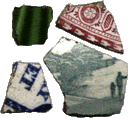
potshard or potsherd - A fragment of broken pottery discarded by an earlier civilization, likely to have settled into firmly stratified mounds over time and provide archaeological chronologies. Because potshards are more commonly known simply as shards, works of art about them or made of them can be seen in the article on shards.
Also see excavate.
potter's wheel - A revolving horizontal disk, sometimes called a head, on which clay is shaped manually into pottery vessels. The simplest form of wheel is the kickwheel. To operate it, the potter kicks or propells some form of disk, crank, or treddle in order to keep the turntable spinning. Also commonly used today are power-driven wheels whose speed can be regulated by the potter as he or she works. The potter's wheel was probably invented either by the Sumerians of the Tigris-Euphrates Basin or by the Chinese around 5000 BCE, perhaps even before the use of wheels for transportation. Potter's wheels continue to be used today, though commercial ceramic manufacture is dominated by slip casting. Nevertheless, they are part of the basic equipment of the artist-potter. Kits of kickwheel parts can be purchased for as little as $200.
Examples:

A Leach wheel. See Bernard Leach's pottery
in the next article.

A kickwheel
to which an electric motor has been attached. The motor drives
the revolving cement disk.
A foot pedal works like a light-dimmer-switch to control the
variable speed of this wheel.
Related link:
Also see bat, centering, and throwing.
pottery - Objects, and especially vessels — pots, which are made from fired clay, including earthenware, stoneware and porcelain. Pots are functional ceramic objects, and may take such forms as plates, bowls, cups, jars, vases, urns, ewers (pitchers), bottles, and boxes. A pottery can also be a place where pots are made.
Examples:

Japan, "Sue Potter," Kofun
Period, 7th century, Tall-necked vase, excavated
from Kaniana Tumulus, Toba-shi, Mie, glazed
pottery, height
55.7, mouth diameter 24.0
cm, Tokyo National Museum. Japanese authorities consider this
to be an "Important Cultural Property." See Japanese art and vase.

Bernard Leach (English, 1887-1979), Deer Plate, 1973-4, lithograph on paper,
image: 48.3 x 41.3 cm, Tate Gallery, London. This and the following
prints depict pots made by Leach — the plate in the late 1920s,
diameter c. 19 inches.

Bernard Leach, Fish Vase, 1973-4, lithograph on paper,
image: 50.8 x 29.8 cm, Tate Gallery, London. Fish Vase
was made c. 1931, height c.
13 inches.
Also see glaze, Index of American Design, kiln, majolica, potter's wheel, sculpture, and terra cotta.
pound - A unit of weight measurement (in the US) equal to 16 ounces. To convert pounds into grams, multiply by 453.59; into kilograms, x 0.4536. Abbreviated lb. or with a #.
pour - The process of filling a mold with the material which will form a sculpture.
Also see casting and lost-wax casting.
Poussinisme - The doctrine that form, rather than color, was the most important element in painting, as it is in the works of Nicolas Poussin (French, 1593/94-1665). It highly valued draftsmanship and linear style of painting. Poussinisme was a movement in seventeenth century France which arose in reaction to Rubénisme, which favored the coloristic brilliance and painterly style of Peter Paul Rubens (Flemish, 1577-1640). The Poussinistes were led by Charles Lebrun (French, 1619-1790), although Lebrun's work shows him emulating Rubens's style along with Poussin's. Rubens, Poussin, the Rubenistes, and the Poussinistes were all active during the Baroque period of art.
(pr. poo-SA-nəzm)
Paintings by Poussin and Lebrun:

Nicolas Poussin (French, 1593/94-1665), Parnassus, oil
on canvas, 145 x 197 cm, Prado
Museum, Madrid. Also see Neoclassicism.
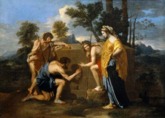
Nicolas Poussin, Arcadian Shepherds (Et in Arcadia Ego),
aka Les Bergers d'Arcadie, Louvre.
This painting has special significance to those who are interested in the theories propounded in the recent best-selling novel The Da Vinci Code, and elsewhere, concerning the (supposed) truth about the Holy Grail (or Sangre Royal ) — a secret kept by the Knights Templar and a mysterious society called the Priory of Zion, or Prieure de Sion. The Priory is said to have been headed at various times by such men as Jacques DeMolay, Leonardo da Vinci, Isaac Newton, Claude Debussy, and Jean Cocteau. Poussin is said to have been one of this society's members, and to have left a clue in this painting. The mountains in the painting are said to represent a range seen near the village of Arques, in the region of Languedoc. One of the shepherds in it points to words carved into a tomb: "Et in Arcadia Ego" . . . In Arcadia I am. The tomb is said to have actually existed near Arques, but it is no longer there, having been suddenly demolished in the late 1960's under mysterious circumstances. The reason: supposedly people were too close to learning the truth of the mystery of the Holy Grail . . . the Sangre Royal. The secret that many powerful people do not want you to know: descendants of a child begat by Christ and Mary Magdalene either lived or continue to live in France to this day.
![]()

![]()
Charles Lebrun (French, 1619-1690), Alexander and Porus, 1673, oil
on canvas. See expression.
A painting by Rubens:
Peter Paul Rubens, Isabella Brant, c. 1620, oil on wood, Cleveland Museum of Art.
https://inform.quest/_art